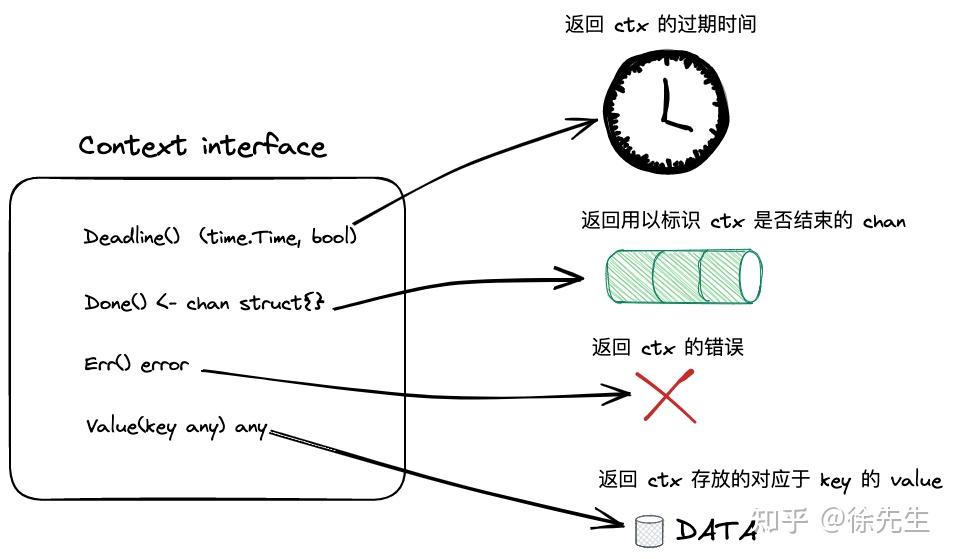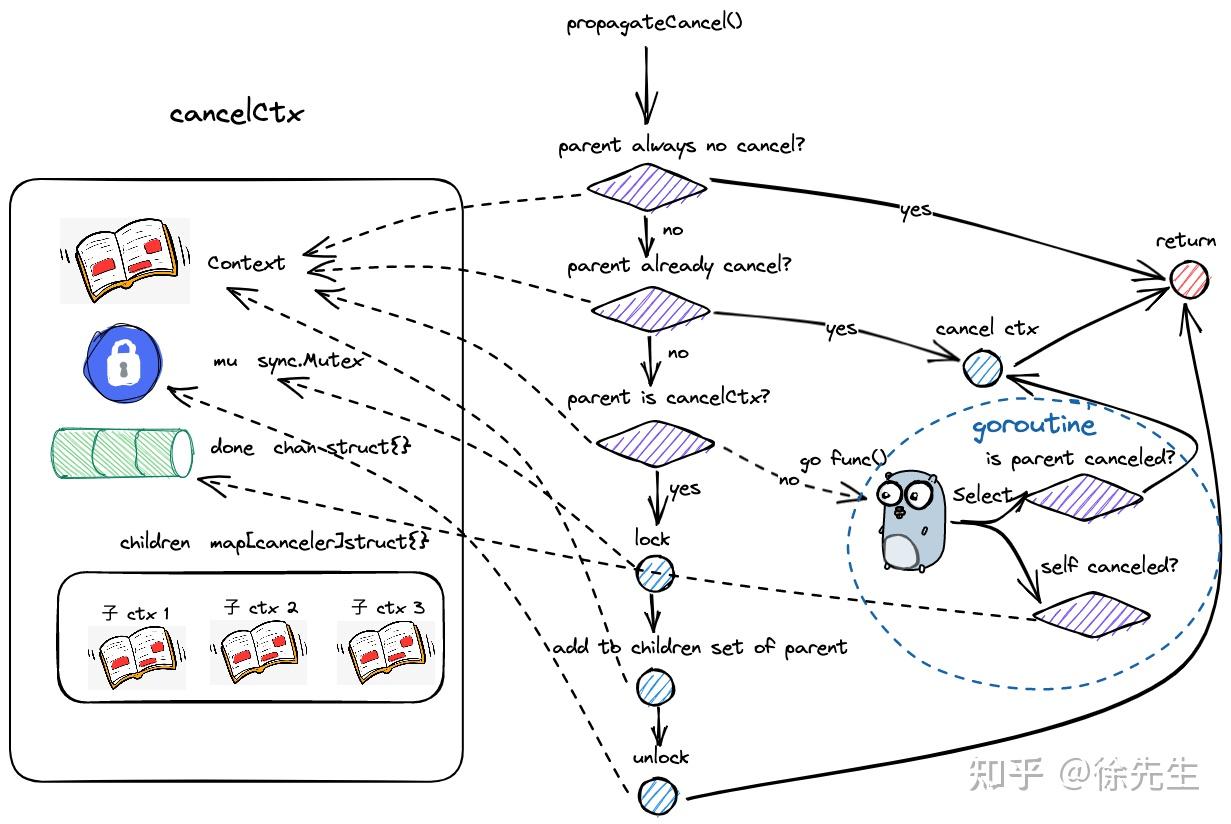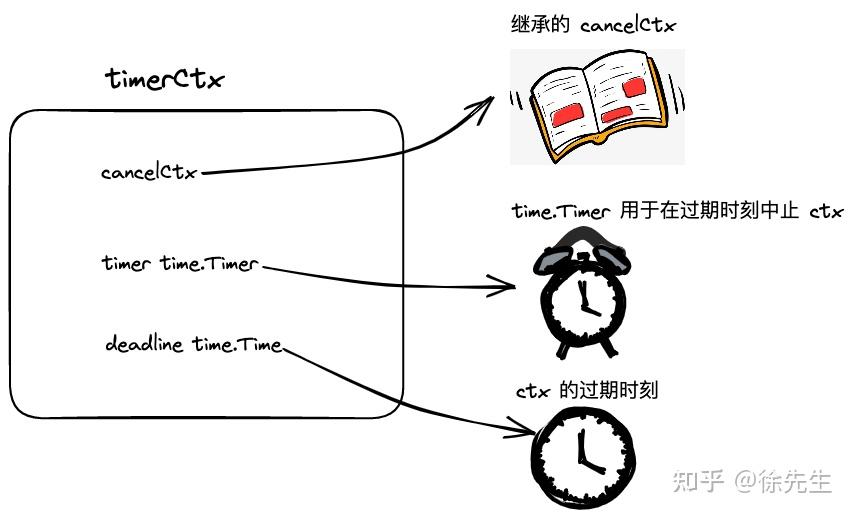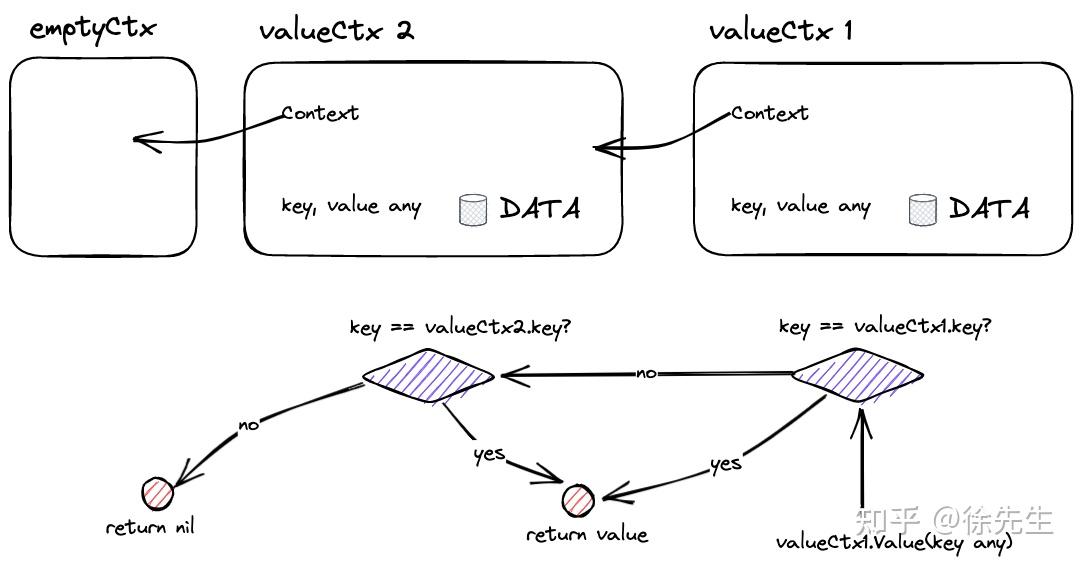本文由 简悦 SimpRead 转码, 原文地址 zhuanlan.zhihu.com
context 是 golang 中的经典工具,主要在异步场景中用于实现并发协调以及对 goroutine 的生命周期控制. 除此之外,context 还兼有一定的数据存储能力. 本着知其然知其所以然的精神,本文和大家一起深入 context 源码一探究竟,较为细节地对其实现原理进行梳理.
1 核心数据结构 1.1 context.Context
1 2 3 4 5 6 type Context interface {bool )chan struct {}error
Context 为 interface,定义了四个核心 api:
(1)Deadline:返回 context 的过期时间;
1.2 标准 error 1 2 3 4 5 6 7 8 9 10 11 12 var Canceled = errors.New("context canceled" )var DeadlineExceeded error = deadlineExceededError{}type deadlineExceededError struct {}func (deadlineExceededError) string { return "context deadline exceeded" }func (deadlineExceededError) bool { return true }func (deadlineExceededError) bool { return true }
(1)Canceled:context 被 cancel 时会报此错误;
(2)DeadlineExceeded:context 超时时会报此错误.
2 emptyCtx 2.1 类的实现 1 2 3 4 5 6 7 8 9 10 11 12 13 14 15 16 17 18 19 20 21 type emptyCtx int func (*emptyCtx) bool ) {return func (*emptyCtx) chan struct {} {return nil func (*emptyCtx) error {return nil func (*emptyCtx) return
(1)emptyCtx 是一个空的 context,本质上类型为一个整型;
(2)Deadline 方法会返回一个公元元年时间以及 false 的 flag,标识当前 context 不存在过期时间;
(3)Done 方法返回一个 nil 值,用户无论往 nil 中写入或者读取数据,均会陷入阻塞;
(4)Err 方法返回的错误永远为 nil;
(5)Value 方法返回的 value 同样永远为 nil.
2.2 context.Background() & context.TODO() 1 2 3 4 5 6 7 8 9 10 11 12 13 var (new (emptyCtx)new (emptyCtx)func Background () return backgroundfunc TODO () return todo
我们所常用的 context.Background() 和 context.TODO() 方法返回的均是 emptyCtx 类型的一个实例.
3 cancelCtx 3.1 cancelCtx 数据结构
1 2 3 4 5 6 7 8 9 10 11 12 13 type cancelCtx struct {map [canceler]struct {} error type canceler interface {bool , err error )chan struct {}
(1)embed 了一个 context 作为其父 context. 可见,cancelCtx 必然为某个 context 的子 context;
(2)内置了一把锁,用以协调并发场景下的资源获取;
(3)done:实际类型为 chan struct{},即用以反映 cancelCtx 生命周期的通道;
(4)children:一个 set,指向 cancelCtx 的所有子 context;
(5)err:记录了当前 cancelCtx 的错误. 必然为某个 context 的子 context;
3.2 Deadline 方法 cancelCtx 未实现该方法,仅是 embed 了一个带有 Deadline 方法的 Context interface,因此倘若直接调用会报错.
3.3 Done 方法
1 2 3 4 5 6 7 8 9 10 11 12 13 14 func (c *cancelCtx) chan struct {} {if d != nil {return d.(chan struct {})defer c.mu.Unlock()if d == nil {make (chan struct {})return d.(chan struct {})
(1)基于 atomic 包,读取 cancelCtx 中的 chan;倘若已存在,则直接返回;
(2)加锁后,在此检查 chan 是否存在,若存在则返回;(double check)
(3)初始化 chan 存储到 aotmic.Value 当中,并返回.(懒加载机制)
3.4 Err 方法 1 2 3 4 5 6 func (c *cancelCtx) error {return err
(1)加锁;
(2)读取 cancelCtx.err;
(3)解锁;
(4)返回结果.
3.5 Value 方法 1 2 3 4 5 6 func (c *cancelCtx) if key == &cancelCtxKey {return creturn value(c.Context, key)
(1)倘若 key 特定值 &cancelCtxKey,则返回 cancelCtx 自身的指针;
(2)否则遵循 valueCtx 的思路取值返回,具体见 2.1.6 小节.
3.6 context.WithCancel() 3.6.1 context.WithCancel() 1 2 3 4 5 6 7 8 func WithCancel (parent Context) if parent == nil {panic ("cannot create context from nil parent" )return &c, func () true , Canceled) }
(1)校验父 context 非空;
(2)注入父 context 构造好一个新的 cancelCtx;
(3)在 propagateCancel 方法内启动一个守护协程,以保证父 context 终止时,该 cancelCtx 也会被终止;
(4)将 cancelCtx 返回,连带返回一个用以终止该 cancelCtx 的闭包函数.
3.6.2 newCancelCtx 1 2 3 func newCancelCtx (parent Context) cancelCtx {return cancelCtx{Context: parent}
(1)注入父 context 后,返回一个新的 cancelCtx.
3.6.3 propagateCancel
1 2 3 4 5 6 7 8 9 10 11 12 13 14 15 16 17 18 19 20 21 22 23 24 25 26 27 28 29 30 31 32 33 34 35 36 37 func propagateCancel (parent Context, child canceler) if done == nil {return select {case <-done:false , parent.Err())return default :if p, ok := parentCancelCtx(parent); ok {if p.err != nil {false , p.err)else {if p.children == nil {make (map [canceler]struct {})struct {}{}else {1 )go func () select {case <-parent.Done():false , parent.Err())case <-child.Done():
propagateCancel 方法顾名思义,用以传递父子 context 之间的 cancel 事件:
(1)倘若 parent 是不会被 cancel 的类型(如 emptyCtx),则直接返回;
(2)倘若 parent 已经被 cancel,则直接终止子 context,并以 parent 的 err 作为子 context 的 err;
(3)假如 parent 是 cancelCtx 的类型,则加锁,并将子 context 添加到 parent 的 children map 当中;
(4)假如 parent 不是 cancelCtx 类型,但又存在 cancel 的能力(比如用户自定义实现的 context),则启动一个协程,通过多路复用的方式监控 parent 状态,倘若其终止,则同时终止子 context,并透传 parent 的 err.
进一步观察 parentCancelCtx 是如何校验 parent 是否为 cancelCtx 的类型:
1 2 3 4 5 6 7 8 9 10 11 12 13 14 15 func parentCancelCtx (parent Context) bool ) {if done == closedchan || done == nil {return nil , false if !ok {return nil , false chan struct {})if pdone != done {return nil , false return p, true
(1)倘若 parent 的 channel 已关闭或者是不会被 cancel 的类型,则返回 false;
(2)倘若以特定的 cancelCtxKey 从 parent 中取值,取得的 value 是 parent 本身,则返回 true. (基于 cancelCtxKey 为 key 取值时返回 cancelCtx 自身,是 cancelCtx 特有的协议).
3.6.4 cancelCtx.cancel
1 2 3 4 5 6 7 8 9 10 11 12 13 14 15 16 17 18 19 20 21 22 23 24 25 26 27 func (c *cancelCtx) bool , err error ) {if err == nil {panic ("context: internal error: missing cancel error" )if c.err != nil {return chan struct {})if d == nil {else {close (d)for child := range c.children {false , err)nil if removeFromParent {
(1)cancelCtx.cancel 方法有两个入参,第一个 removeFromParent 是一个 bool 值,表示当前 context 是否需要从父 context 的 children set 中删除;第二个 err 则是 cancel 后需要展示的错误;
(2)进入方法主体,首先校验传入的 err 是否为空,若为空则 panic;
(3)加锁;
(4)校验 cancelCtx 自带的 err 是否已经非空,若非空说明已被 cancel,则解锁返回;
(5)将传入的 err 赋给 cancelCtx.err;
(6)处理 cancelCtx 的 channel,若 channel 此前未初始化,则直接注入一个 closedChan,否则关闭该 channel;
(7)遍历当前 cancelCtx 的 children set,依次将 children context 都进行 cancel;
(8)解锁.
(9)根据传入的 removeFromParent flag 判断是否需要手动把 cancelCtx 从 parent 的 children set 中移除.
走进 removeChild 方法中,观察如何将 cancelCtx 从 parent 的 children set 中移除:
1 2 3 4 5 6 7 8 9 10 11 func removeChild (parent Context, child canceler) if !ok {return if p.children != nil {delete (p.children, child)
(1)如果 parent 不是 cancelCtx,直接返回(因为只有 cancelCtx 才有 children set)
(2)加锁;
(3)从 parent 的 children set 中删除对应 child
(4)解锁返回.
4 timerCtx 4.1 类
1 2 3 4 5 6 type timerCtx struct {Timer // Under cancelCtx.mu.Time
timerCtx 在 cancelCtx 基础上又做了一层封装,除了继承 cancelCtx 的能力之外,新增了一个 time.Timer 用于定时终止 context;另外新增了一个 deadline 字段用于字段 timerCtx 的过期时间.
4.2 timerCtx.Deadline() 1 2 3 func (c *timerCtx) bool ) {return c.deadline, true
context.Context interface 下的 Deadline api 仅在 timerCtx 中有效,由于展示其过期时间.
4.3 timerCtx.cancel 1 2 3 4 5 6 7 8 9 10 11 12 func (c *timerCtx) bool , err error ) {false , err)if removeFromParent {if c.timer != nil {nil
(1)复用继承的 cancelCtx 的 cancel 能力,进行 cancel 处理;
(2)判断是否需要手动从 parent 的 children set 中移除,若是则进行处理
(3)加锁;
(4)停止 time.Timer
(5)解锁返回.
4.4 context.WithTimeout & context.WithDeadline 1 2 3 func WithTimeout (parent Context, timeout time.Duration) return WithDeadline(parent, time.Now().Add(timeout))
context.WithTimeout 方法用于构造一个 timerCtx,本质上会调用 context.WithDeadline 方法:
1 2 3 4 5 6 7 8 9 10 11 12 13 14 15 16 17 18 19 20 21 22 23 24 25 26 27 func WithDeadline (parent Context, d time.Time) if parent == nil {panic ("cannot create context from nil parent" )if cur, ok := parent.Deadline(); ok && cur.Before(d) {return WithCancel(parent)if dur <= 0 {true , DeadlineExceeded) return c, func () false , Canceled) }defer c.mu.Unlock()if c.err == nil {func () true , DeadlineExceeded)return c, func () true , Canceled) }
(1)校验 parent context 非空;
(2)校验 parent 的过期时间是否早于自己,若是,则构造一个 cancelCtx 返回即可;
(3)构造出一个新的 timerCtx;
(4)启动守护方法,同步 parent 的 cancel 事件到子 context;
(5)判断过期时间是否已到,若是,直接 cancel timerCtx,并返回 DeadlineExceeded 的错误;
(6)加锁;
(7)启动 time.Timer,设定一个延时时间,即达到过期时间后会终止该 timerCtx,并返回 DeadlineExceeded 的错误;
(8)解锁;
(9)返回 timerCtx,已经一个封装了 cancel 逻辑的闭包 cancel 函数.
5 valueCtx 5.1 类
1 2 3 4 type valueCtx struct {
(1)valueCtx 同样继承了一个 parent context;
(2)一个 valueCtx 中仅有一组 kv 对.
5.2 valueCtx.Value()
1 2 3 4 5 6 func (c *valueCtx) if c.key == key {return c.valreturn value(c.Context, key)
(1)假如当前 valueCtx 的 key 等于用户传入的 key,则直接返回其 value;
(2)假如不等,则从 parent context 中依次向上寻找.
1 2 3 4 5 6 7 8 9 10 11 12 13 14 15 16 17 18 19 20 21 22 23 24 25 func value (c Context, key any) for {switch ctx := c.(type ) {case *valueCtx:if key == ctx.key {return ctx.valcase *cancelCtx:if key == &cancelCtxKey {return ccase *timerCtx:if key == &cancelCtxKey {return &ctx.cancelCtxcase *emptyCtx:return nil default :return c.Value(key)
(1)启动一个 for 循环,由下而上,由子及父,依次对 key 进行匹配;
(2)其中 cancelCtx、timerCtx、emptyCtx 类型会有特殊的处理方式;
(3)找到匹配的 key,则将该组 value 进行返回.
5.3 valueCtx 用法小结 阅读源码可以看出,valueCtx 不适合视为存储介质,存放大量的 kv 数据,原因有三:
(1)一个 valueCtx 实例只能存一个 kv 对,因此 n 个 kv 对会嵌套 n 个 valueCtx,造成空间浪费;
(2)基于 k 寻找 v 的过程是线性的,时间复杂度 O(N);
(3)不支持基于 k 的去重,相同 k 可能重复存在,并基于起点的不同,返回不同的 v.
由此得知,valueContext 的定位类似于请求头,只适合存放少量作用域较大的全局 meta 数据.
5.4 context.WithValue() 1 2 3 4 5 6 7 8 9 10 11 12 func WithValue (parent Context, key, val any) if parent == nil {panic ("cannot create context from nil parent" )if key == nil {panic ("nil key" )if !reflectlite.TypeOf(key).Comparable() {panic ("key is not comparable" )return &valueCtx{parent, key, val}
(1)倘若 parent context 为空,panic;
(2)倘若 key 为空 panic;
(3)倘若 key 的类型不可比较,panic;
(4)包括 parent context 以及 kv 对,返回一个新的 valueCtx.










